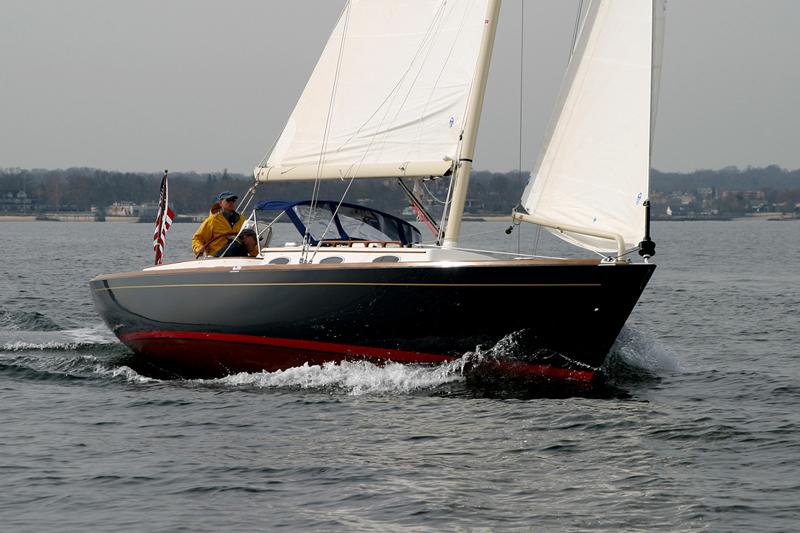A coastal cruiser is born from the roots of her daysailing predecessors
In college when I wasn’t out sailing, or of course, studying, I managed to carve out a side business of maintaining sailboats for their owners. One of my favorite boats was a sweet new Alerion 28 that sat on a lift in Naples, Florida. She was beautiful and I took care of that boat like it was my own. The owner used her as she was intended—singlehanding as a daysailer, casually racing around the cans or taking off for short stints of cruising. When I finally got a chance to sail her, I was pretty sure the boat was perfect.
Fast-forward a decade and the Alerion brand has grown to include models ranging from 20 feet to their newly minted 41. Now under the venerable umbrella of US Watercraft, the newest incarnation of Alerion Yachts still offers the same impeccable quality and timeless look, mixed with just the right mount of performance to attract a wide audience of cruisers.
ON THE WATER
A steel grey autumn sky and light breeze was the order of the day as I found the Alerion 41 tied up at Bert Jabin Yacht Yard in Annapolis, Maryland. I was greeted there by Scott Bryant from Alerion who invited me aboard and promptly started the engine as I chatted with the two other crewmembers joining us for the sail.
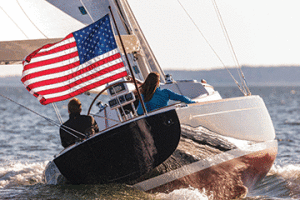 As we motored out of Back Creek we fell into a procession of other boats heading out for test sails that morning and it was apparent that we’d all be bobbing around until some wind filled in.
As we motored out of Back Creek we fell into a procession of other boats heading out for test sails that morning and it was apparent that we’d all be bobbing around until some wind filled in.
The 41’s destroyer wheel allowed for good sightlines from both sides of the helm and the 40 horsepower Yanmar diesel, nestled underneath the cockpit, topped out at around 7 knots before we throttled back to match our boat speed with the parade.
Once out on the Chesapeake the wind was barely at a whisper as our crew asked Scott how we could assist with setting the main and jib. But wait, he insisted. This boat, as are all Alerions, was designed to be singlehanded, which meant that the helmsperson alone could raise and trim the mainsail and set and trim the jib. So we sat and watched as the demonstration commenced.
Sitting on the port side of the helm, Scott turned the boat head to wind, eased the mainsheet, and with the touch of a button, raised the boat’s large elliptical mainsail through the lazy jacks. He then fell off the wind and trimmed the main in slightly before reaching for the jib sheet and furling line and rolling out the vertical battened headsail onto its self-tacking jib boom. The entire process probably took less than three minutes.
In doing all this sail work, he had literally only moved a couple feet from the helm. It was easy to see why he didn’t need any help. And had it been sunset not 9:30 in the morning, our crew could have just kicked back with cold beers while he sailed us around.
With the demonstration over, Scott relinquished the helm and I gladly took his seat to see what we could do in a breeze that was just around five knots. To my surprise, as I came on the wind our boat speed climbed to about 4.3 knots, indicating a boat that could definitely keep some way on in the light stuff. And judging from her design numbers—SA/D of 23.5—, this is certainly true. The Gori folding prop also lent a hand in the light air by not dragging us down.
In the gentle breeze we were given, the 41 was close winded and steered smoothly through a 90 degree tacking angle. And when we fell off to a beam reach our speed stayed in the 3.5 to 4 knot range. We briefly pointed her to a broad reach and though I expected the jib to collapse due to lack of pressure, the below deck gas spring kept the self-tacking jib boom held slightly outboard, which was kind of neat.
 Unfortunately, we effectively used every bit of wind that was on the water that morning. But, that did allow us to get a thorough look around at the 41’s many sail-handling intricacies. In keeping with the desire to make the boat a true singlehander, Harken Rewind™ reversible self-tailing winches are mounted to port and starboard of the helm accompanied by sets of line clutches that enable the helmsperson to trim or ease nearly every line on the boat. And all these lines are led under the deck, and have built-in stowage in the cockpit to keep them out of the way while leaving the boat with an overall clean look.
Unfortunately, we effectively used every bit of wind that was on the water that morning. But, that did allow us to get a thorough look around at the 41’s many sail-handling intricacies. In keeping with the desire to make the boat a true singlehander, Harken Rewind™ reversible self-tailing winches are mounted to port and starboard of the helm accompanied by sets of line clutches that enable the helmsperson to trim or ease nearly every line on the boat. And all these lines are led under the deck, and have built-in stowage in the cockpit to keep them out of the way while leaving the boat with an overall clean look.
DESIGN
Alerion’s longtime modus operandi has been to create great looking and sailing boats that are easy to singlehand, so that their owners can use every bit of available free time to get out on the water. That was true with the owner I worked for in Naples and is still true today. Actually, Scott explained to me that the Alerion 41 was purely conceived upon customer demand. Owners of their previous models wanted an Alerion that they could truly take on an extended coastal cruise, but would still maintain the ease of handling and performance of their previous boats.
So building on the Alerion Express 33 and 38’s elegant profiles and with simplicity, cruise-ability and performance in mind, Alerion went out and designed and built the 41 to hit all the points a discerning owner of a fine-looking and sailing daysailer and cruiser would want. Starting at the bow, and unique to the 41, is a smartly conceived anchor locker with a retractable anchor and roller that easily folds back into the anchor well. This compliments the overall look of the boat by not spoiling her sheer, while providing the functionality of a sturdy anchor and windlass setup for cruising.
On the performance side, the 41 is as modern as her predecessors below the waterline with a fin keel and slight bulb, and large spade rudder. The rig is sporty as well with a backstay-less carbon fiber mast and aluminum boom—a Leisurefurl system or Hall Vboom are also options.
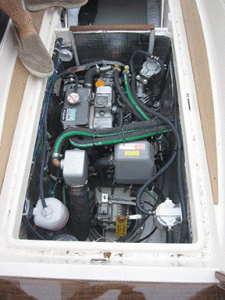 The cockpit on any Alerion is home base and I liked how the 41’s was laid out. Large enough to happily fit eight people with an optional table, the settees are deep enough to be comfortable while also allowing for proper views. The helm and sail controls are far enough aft that the crew won’t be in the way of the person running the boat. And the mainsheet is led to a traveler just aft of the helm, allowing for end of boom sheeting that also keeps that whole mess clear of people sitting in the cockpit.
The cockpit on any Alerion is home base and I liked how the 41’s was laid out. Large enough to happily fit eight people with an optional table, the settees are deep enough to be comfortable while also allowing for proper views. The helm and sail controls are far enough aft that the crew won’t be in the way of the person running the boat. And the mainsheet is led to a traveler just aft of the helm, allowing for end of boom sheeting that also keeps that whole mess clear of people sitting in the cockpit.
When it comes time to work on the engine, the floor of the cockpit raises up on gas springs, creating easy access that would make doing the necessary pre-sail checks a simple process. A removable panel also creates a standing and working space, so servicing the engine can be done efficiently.
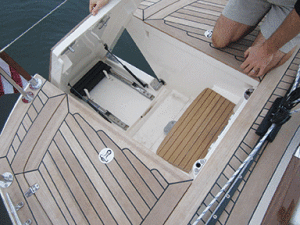 One of my favorite features on deck, though, is aft of the cockpit. Recognizing the need for cruisers to be able to easily get in and out of the water or a dinghy, Alerion came up with one of the best looking and functioning stern platforms I’ve come across. What appears to be a large lazarette on deck actually folds up and aft to create a platform that a stern ladder can then articulate from. The overall look of the platform doesn’t detract from the boat’s appearance at anchor and is probably the perfect height for a family to get in and out of a RIB.
One of my favorite features on deck, though, is aft of the cockpit. Recognizing the need for cruisers to be able to easily get in and out of the water or a dinghy, Alerion came up with one of the best looking and functioning stern platforms I’ve come across. What appears to be a large lazarette on deck actually folds up and aft to create a platform that a stern ladder can then articulate from. The overall look of the platform doesn’t detract from the boat’s appearance at anchor and is probably the perfect height for a family to get in and out of a RIB.
LIVING ABOARD
Down below, the Alerion design team kept with the theme of taking the 41 from its daysailer roots to a more comfortable cruiser. When stepping down the companionway, 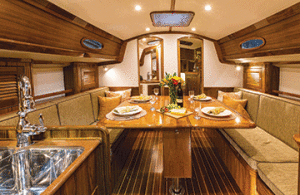 the interior woodwork and finish is absolutely striking. The hand-finished joinery can be had in American Cherry or teak, and white bulkheads gave the version we sailed a light and airy feel, even on a grey fall day.
the interior woodwork and finish is absolutely striking. The hand-finished joinery can be had in American Cherry or teak, and white bulkheads gave the version we sailed a light and airy feel, even on a grey fall day.
The 41 comes standard with two cabins, which will make a good cruising layout for two couples or a family of four, and the settees are long enough to allow sleeping room for a few more. The forward V-berth is certainly the owner’s suite and the amount of storage, including a cedar-lined hanging locker, creates enough room for clothes and gear to be kept out of sight.
The starboard aft cabin is not huge and doesn’t need to be. There is enough room for two people to sleep and store clothes. And it could also make for a suitable spot to take a nap while the boat is underway.
Many would agree that a single head is all that is necessary on a boat of this size and Alerion has tucked one just forward of the saloon to port. Access to the head is available through the main saloon or through the V-berth. The main saloon is large enough to fit six adults comfortably for a meal and with six and a half feet of headroom, the boat doesn’t feel like a cave. The nav table is to starboard with a small chart table suitable for a laptop or chart book. Above and outboard of the chart table, the boat’s electrical panel is neatly tucked behind a locker face. The nav table also drops down to allow for the starboard settee to become a full-length berth.
Scott mentioned that while the layout of the 41 is standard, they would work with an owner to customize storage spaces and galley options. Standard for the galley is a two burner stove with a lift-up cover that gives the cook more counter space, a double stainless sink, microwave and refrigerator. There is plenty of storage and a specifically designed drawer for bottles will undoubtedly get some use when happy hour is closed.
BWS THOUGHTS
Though we weren’t able to get the 41 out in even a moderate breeze, she sailed extremely well in the light air we were given and I have no reason to believe the boat would behave erratically in a blow—especially with two reefs in the big beautiful main. I like the engine setup underneath the cockpit, and the saildrive with folding Gori prop is always a nice touch.
What struck me the most about Alerion’s newest ride is the attention to detail throughout that remains loyal to the company’s history and principles. By taking what they’ve learned with their previous daysailer models and improving upon them with cruising touches, they’ve surely created a boat for the modern cruising sailor.
While owners probably aren’t going to take the 41 across blue water with any frequency—though you probably could if properly outfitted—, I do think they’ve done a great job of making a coastal cruiser that is just as easy to get out for a sunset sail as it is to take off on for a week or two. And though I’m not in the boat maintenance business any more, I’d gladly move up to pampering an Alerion 41 if duty called.
Alerion 41
Length Overall: 40′ 6″
Waterline Length: 30′ 6″
Beam: 11′ 6″
Draft: 6′ 6″
Shoal draft: 5′ 6″
SA/D: 23.5
Mast Height: 56′
Ballast: 6,000 pounds
Sail Area: 942 sq. feet
Displacement: 16,000 pounds
Auxiliary: 40 hp saildrive
For more information about the Alerion 41, visit www.alerionexp.com
Photos courtesy of Onne van der Wal
















